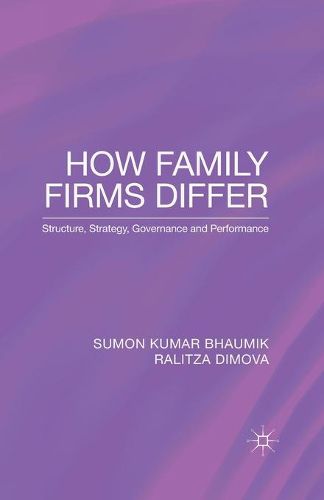Readings Newsletter
Become a Readings Member to make your shopping experience even easier.
Sign in or sign up for free!
You’re not far away from qualifying for FREE standard shipping within Australia
You’ve qualified for FREE standard shipping within Australia
The cart is loading…






This title is printed to order. This book may have been self-published. If so, we cannot guarantee the quality of the content. In the main most books will have gone through the editing process however some may not. We therefore suggest that you be aware of this before ordering this book. If in doubt check either the author or publisher’s details as we are unable to accept any returns unless they are faulty. Please contact us if you have any questions.
Family firms account for a large proportion of firms in most countries. In industrialised countries of North America and Western Europe, they generally account for a large share of small and medium sized enterprises. In emerging market economies such as India, they also account for the majority of the large firms. Their importance for factors such as employment creation notwithstanding, relative to the widely held Anglo-Saxon firms, which are ubiquitous in the economics, finance and management literatures, family firms have historically received much less attention from scholars of these disciplines.
However, in part owing to increased focus on emerging markets, there is a growing literature on family firms. In How Family Firms Differ, the authors explore important aspects of family firms, drawing on the existing literature and their own research on these firms.
$9.00 standard shipping within Australia
FREE standard shipping within Australia for orders over $100.00
Express & International shipping calculated at checkout
This title is printed to order. This book may have been self-published. If so, we cannot guarantee the quality of the content. In the main most books will have gone through the editing process however some may not. We therefore suggest that you be aware of this before ordering this book. If in doubt check either the author or publisher’s details as we are unable to accept any returns unless they are faulty. Please contact us if you have any questions.
Family firms account for a large proportion of firms in most countries. In industrialised countries of North America and Western Europe, they generally account for a large share of small and medium sized enterprises. In emerging market economies such as India, they also account for the majority of the large firms. Their importance for factors such as employment creation notwithstanding, relative to the widely held Anglo-Saxon firms, which are ubiquitous in the economics, finance and management literatures, family firms have historically received much less attention from scholars of these disciplines.
However, in part owing to increased focus on emerging markets, there is a growing literature on family firms. In How Family Firms Differ, the authors explore important aspects of family firms, drawing on the existing literature and their own research on these firms.